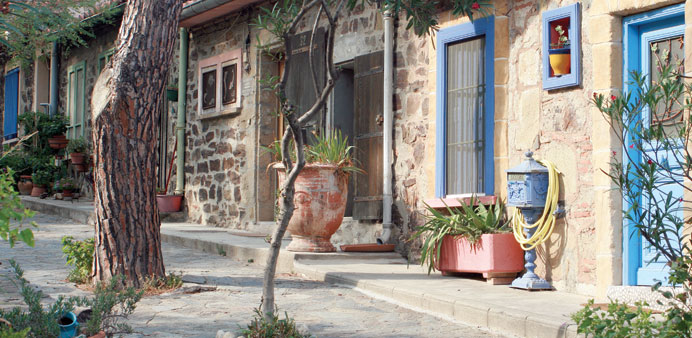Colourful houses in Le More, a section of Collioure where many dealer galleries offering paintings to tourists are located.
By Bernd F Meier
Pixie Bechal has set up her easel atop the narrow harbour pier. For a dozen years now, the painter from London has kept coming back to Collioure on the Côte Vermeille, the red coast in the southernmost part of France close to the border with Spain.
“The light here is unusually gentle. Collioure is an especially pretty place to stay in and to paint,” she says.
Painting in Collioure has a long tradition. In 1904, Henri Matisse and fellow-painter André Derain visited the sleepy fishing village on the Mediterranean, and both were inspired by the scenery and splendid colours all around — the red-tiled roofs, the blue shutters, the gentle pink of the houses’ walls, sailboats in the old harbour, the narrow alleys and the unusual steeple of the Notre Dame des Anges church.
“For Matisse, Collioure was the ideal spot to pursue his art. He got a tip about the pretty town from relatives living nearby in Perpignan,” art expert Nati Zorzo explains during a walking tour along the Chemin du Fauvisme, or the path of the Fauvists.
The Fauvists were a school that painted in brilliant colours. “Matisse and Derain were the founders of Fauvism,” he said.
Today, the Fauvism Art Trail leads to 20 spots where Matisse, Derain and other painters set up their easels and created their powerfully colourful works. Along the route are information boards with reproductions of the art works.
The originals are on display in the Museum of Modern Art in New York, the Hermitage in St Petersburg, the Folkwang Museum in Essen, Germany and other world-class art galleries.
Art guide Zorzo has her small group stop in front of house number 22 on the Rue de la Démocratie. “It was on this spot that in 1905 Matisse created his most important work, The Open Window,” she says.
Matisse and Derain were the first to paint themes in Collioure.
In later years artists like Georges Braque, Raoul Dufy, Albert Marquet and Pablo Picasso would follow.
The remote fishing village’s history goes far back, with a fortress dating to the 7th century. Later the kings of Majorca built a huge fortress between 1276 and 1344. It towers over the village from a rise.
It was in the 1950s that the first vacationers discovered Collioure. Today, tourists push their way through the crowded alleys to see the sights, including the Notre Dame des Anges church, built in 1684.
Its steeple is a bit unconventional-looking, since it also used to serve the town as a lighthouse guiding mariners on the Mediterranean.
Somewhat more tranquil is the old district of the Vieux Quartier du Mouré, where the alleys leading from the church rise steeply upward. Flowers decorate the houses and some of the more than 30 art galleries of Collioure are here with their collections of oil paintings, drawings and sculptures.
Art lovers will seek out the hotel-restaurant Les Templiers, where painting upon painting covers the walls. According to legend, it started when one artist short on money paid his bills with paintings.
Later on, Matisse, Picasso and Salvadore Dali frequented Les Templiers and decorated the guest book with tiny humourous drawings.
Some 30km inland, the artists’ village of Céret is a place of tranquillity. But in January 1910 the sleepy town in the foothills of the Pyrenees was shaken from its peace and quiet when sculptor Manolo Martínez Hugué, painter Frank Burty Haviland and composer Deodat de Séverac arrived.
This triggered a wave of arts tourism in the following years. Picasso, Braque, Juan Gris, Marc Chagall and many others would come to Céret up into the 1930s, making the town into the epicentre of Cubism.
Besides the galleries and ateliers to be found in the narrow streets of the old town centre, Céret’s chief attraction is the Museum of Modern Art, located in a former Carmelite monastery.
Here, masterpieces of Cubism are to be seen, along with exhibitions of contemporary artists. After a visit to the galleries and museums, visitors might just head to the ‘Grand Café’, just like Picasso was known to do. – DPA
Pixie Bechal, British painter, who is a regular visitor to Collioure, where she sets up her easel on the harbour mole to paint.

